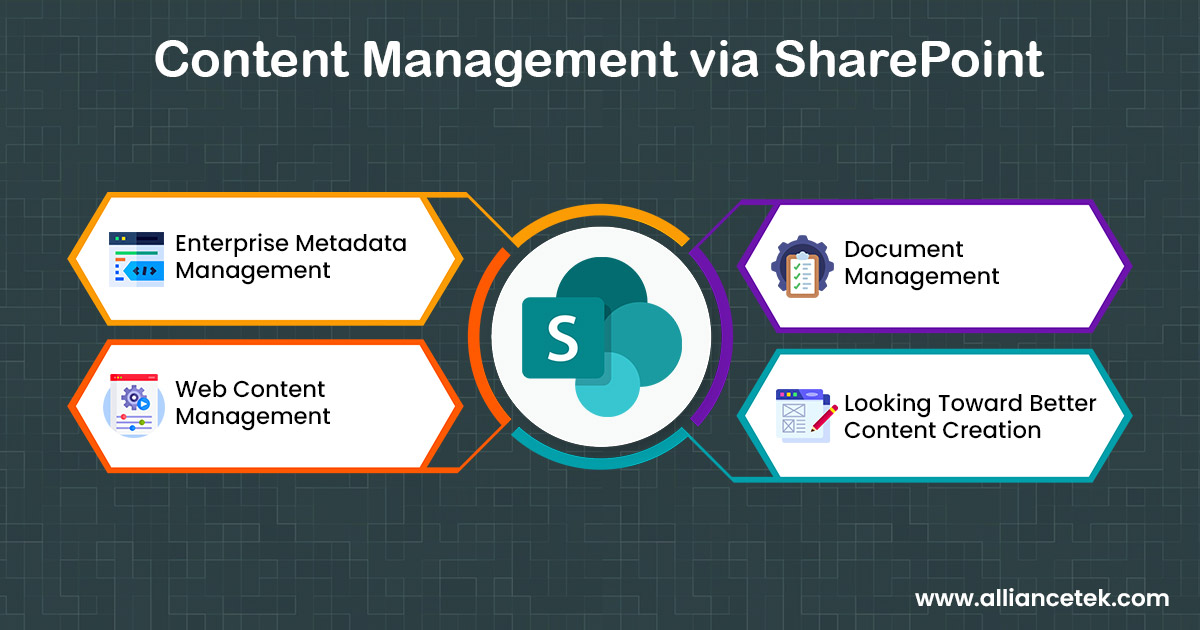Navigating the labyrinth of content management within any organization is pivotal for leveraging valuable assets and ensuring they're readily available. An adept content management strategy not only ensures the integrity and quality of content but also promotes its reuse and meticulously tracks its evolution over time. Thus, the choice of a content management system (CMS) becomes a cornerstone in the edifice of business success.
In enterprise-level content management system, one often encounters solutions that are not only costly but also embody complexity and present a steep learning curve for implementation. Amidst this landscape, SharePoint emerges as a beacon of hope for its comparative ease of deployment and user-friendly interface.

It's not uncommon to discover SharePoint already laying its roots in some corner of your organization. For those yet to acquaint themselves with its capabilities, the adoption journey is far from daunting. SharePoint offers a gateway to its world through free versions, eliminating the barriers of high costs and intricate setup processes. It comes equipped with robust document management and content management functionalities, allowing for an immediate plunge into its ecosystem without the necessity for elaborate implementation projects or extensive training programs.
The content management issues at the enterprise level are diverse, requiring sophisticated search capabilities, scalability for growth, and strict record management. SharePoint has an adaptable framework that is excellent in dealing with those complexities and it offers complete solutions for multimedia enterprise-level content management needs.
Enterprise Metadata Management
Enterprise Metadata Management elevates the handling of metadata and the sharing of content types across various sites and applications to a new level of efficiency. This cutting-edge managed metadata service grants users the capability to ensure consistent metadata and shared taxonomies across numerous SharePoint solution servers within an organization, streamlining the process of content management and integration.
The significance of thorough and accurate content discovery cannot be overstated for any organization. The presence of uniform and managed metadata across multiple sites simplifies the task of searching for specific data and information, making it a straightforward endeavour. This level of precision in content discovery is pivotal for maintaining operational efficiency and ensuring that critical information is readily accessible when needed.
Diving into the core functions of metadata management, we find it encompasses several key areas:
- The term creation and management is the basis of the organized and structured content model.
- Metadata and taxonomy construction and upkeep, maintaining that content is classified and managed in an organized and systematized way.
- The use of keywords and tagging improves content discoverability and makes searching too easy and accurate.
- All of these functions together help to form a good metadata management policy that allows organizations to use their content to the maximum. Efficient management of metadata ensures that the content of the enterprise is well-organized and makes it accessible and reusable thus guaranteeing that it maximizes its value and use within the organization.
Web Content Management
SharePoint facilitates the process of developing and administering websites, especially intranets, by providing a complete set of functions for web content management. The functions are meant to unify the management of all web content, from creation to publication, making sure that companies can support a productive and responsive digital identity.
# Management and Deployment of Websites at Low Cost
SharePoint provides tools that enable organizations to manage and deploy websites without significant investment. Being affordable, this accessibility enables businesses of all shapes and sizes to create a strong online presence. The user-oriented interface of the platform facilitates fast site setup and site deployment, eliminating the need for profound technical knowledge and, consequently, decreasing web development and management costs.
# Authoring and Publishing Content Effectively and Quickly
The platform facilitates the efficient authoring and publishing of content. Using SharePoint, the creators of content can easily create, edit, and publish web content, which makes the content lifecycle process easier.
Efficiency is central to this, by making sure that the content of the website is always fresh and relevant so that organizations can respond quickly to new information needs or market trends.
# Consistent Navigation Across Multiple Sites
SharePoint ensures that users experience consistent navigation across all of an organization's sites. This level of reliability is essential for usability, letting visitors find what they are looking for without any confusion. Having a consistent navigation structure, SharePoint helps establish an integrated digital environment that portrays the brand of the organization and makes content more accessible.
These content creators and end-users benefit not only from the simplification and streamlining of web development and content management but also from the greater enhancement of the entire digital experience thanks to a web content management system powered by SharePoint that focuses on these key functions.
Document Management
Document Management via SharePoint shifts the document management paradigm by providing organizations with a well-organized and effective means for storing, accessing, and collaborating on files. SharePoint organizes folders of documents and in addition, it improves the discoverability of these files by tagging them with metadata.
This system plays a significant role in promoting teamwork among the team members, as it allows the checking in and out of documents, controls complex workflows, and keeps an accurate record of version history.
Functions of document management within SharePoint:
# Document Libraries
Act as the heart of SharePoint’s document management system, which is used as a central location for storing and organizing documents. These libraries are not just repositories but have been designed to facilitate the users’ interaction with documents, enabling easy retrieval, sharing, and management.
# Version and Source Control
The version control feature of SharePoint is a game changer in document management. It enables every action carried out on a document to be recorded and the changes to be saved by the system for users to check versions and restore if they need to. This feature is very important for the preservation of the document integrity and successful cooperation between the team members.
# Workflows with Transition Management
SharePoint enables the building and control of workflows that automate the document review and approval process. This system helps eliminate the waste of time in moving the document through each phase of a process, making each stage happen at the right time, and in the right manner.
Besides these basic functions, the SharePoint document management feature enables the storing and quick reaching of crucial documents as well as images. This is reinforced by the calendar system of the platform, which makes meeting management smooth. The combination of document management with calendar features promotes the systematization and productivity of the workflow, covering all aspects of project management within one integrated system.
Looking Toward Better Content Creation
Technology democratization within organizations when using platforms such as SharePoint allows the users to assume control over the implementation of a program without necessarily having to be attended to all the time by the IT department.
This change not only frees IT resources that are often overloaded due to the needs of daily activities but also reduces the costs of IT support and program deployment.SharePoint allows users to directly execute and control programs, consequently doing away with the attritional IT bottleneck, and creating a more dynamic and responsive organizational environment.
An exceptional instance of this empowerment is that users of the software can produce and disseminate a regular newsletter. The newsletter is more than a communication instrument since it is aflame with notifications, news, and discoveries; this document is an icon of user independence within the framework of SharePoint.
It enables people and groups to communicate critical updates and knowledge directly with their peers without the need for technical help in content creation and dissemination. This user-generated communication approach helps to boost communication both within and outside the organization and at the same time, promotes a culture of teamwork and creativity.
The life-changing effect of a SharePoint solution on an enterprise is huge. By making communication streamlined, the programs easier to implement, and user autonomy more improved, SharePoint thus makes the foundation for an effective, result-oriented, and interconnected organizational scene.
This feature of the platform to eliminate technological boundaries and facilitate direct user interaction with digital tools delivers significant enhancements in operational efficiency and productivity. SharePoint is much more than a content management and collaboration tool; it is a trigger of a whole organization transformation that makes an enterprise go in a direction where every technology user will contribute to the common success.


